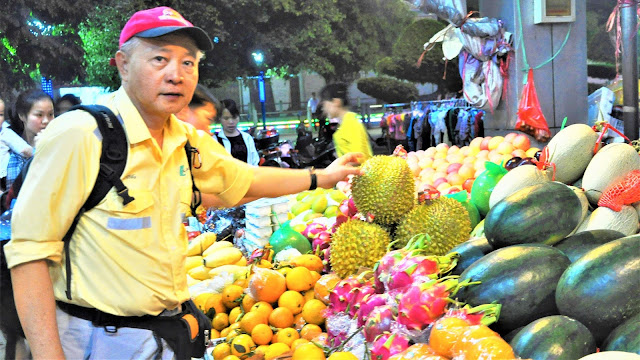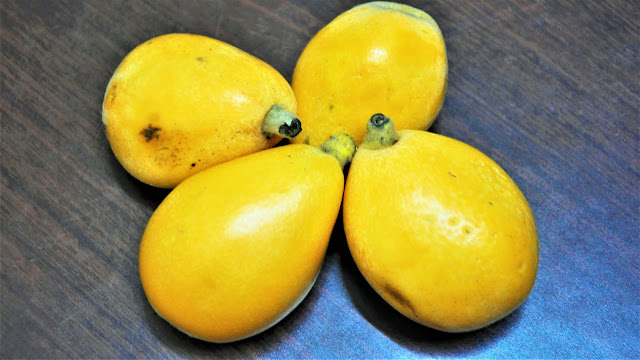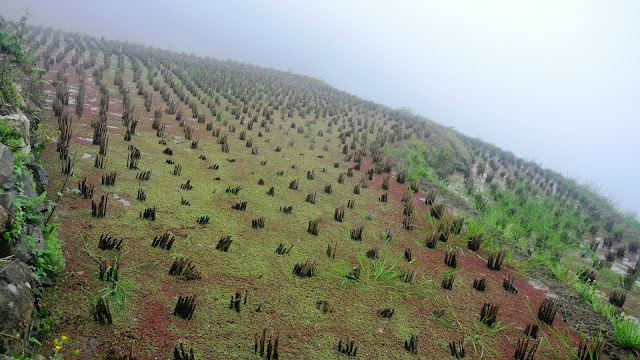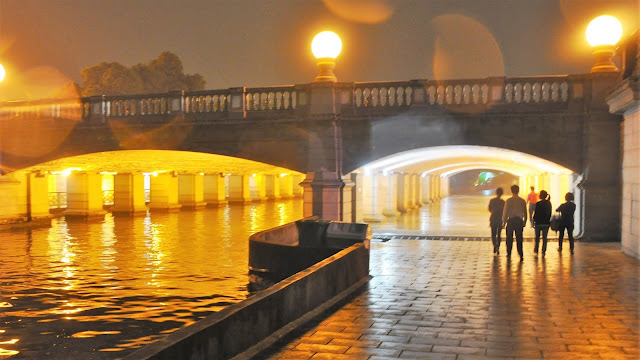
L-R: See Beow Aun, Cindy Chong, Bernard Lee, Chan Meng Fye, Peter, Chew Leng Soon, Lim Peng Peng, Gan Choi Geok, Ching Neng Bin, Lee Kam Boon at Longji rice terrace in Longsheng
Day 19 (16.04.2011) Congjiang > Sanjiang > Longsheng Yao Village of Dazhai
We took the 8.30am bus (Y32) from Congjiang to Sanjiang, arriving at 10.30pm. From here we took another bus (Y19) to Longsheng city arriving at 1.40pm. We called up the owner of Dazhai Tavern guesthouse and was kind to sent 2 vans (Y160) to pick us up at Longsheng City to Dazhai Village.
The entrance fee to Dazhai Village is Y60 and for senior citizen Y50. In the afternoon we went for a short trek and came back at 7pm for a good dinner prepared by the family of the Dazhai Tavern guesthouse. In the evening, the group members celebrated Ching Neng Bin's birthday with a birthday song, good food, beers and a T-shirt present.
Sleeping at Dazhai Tavern a family operated guesthouse.
We checked out of the Culture Br. aocasting Hotel in Congjiang.
The locals still continue to dress in their ethnic clothes in Congjiang.
We took the 8.30am bus (Y32) from Congjiang to Sanjiang, arriving at 10.30pm.
From Congjiang to Sanjiang our backpacks piled high up behind the bus driver.
There are also many birds seating with us in the bus from Congjiang to Sanjiang.
The route from Congjiang to Sanjiang meanders along the river with great scenery. Sanjiang means three rivers, named after the three rivers in the county, Rong River, Xun River and Miao River.
The route from Congjiang to Sanjiang meanders along the river with great scenery. Sanjiang means three rivers.
The route from Congjiang to Sanjiang meanders along the river with great scenery. Sanjiang means three rivers.
The route from Congjiang to Sanjiang meanders along the river with great scenery. Sanjiang means three rivers.
Arrived Sanjiang, then switch to another bus towards Longsheng. From here we took another bus (Y19) to Longsheng arriving at 1.40pm.
The route from Sanjiang to Longsheng again meanders along the river with great scenery.
Longsheng city arriving at 1.40pm. We called up the owner of Dazhai Tavern guesthouse and was kind to sent 2 vans (Y160) to pick us up at Longsheng City.
A row of double storey terrace houses by the road side hill slope from Longsheng city to Dazhai Village.
The entrance to Dazhai Village - our van can't pass beyond the entrance gate, so as to allow these long hair women to earn some porter fees of Y5 per bag.

Map of Longji terraced fields scenic area. The Longji Rice Terraces are
split into two sections, Ping’an Zhuang Village Terraced Fields and
Jinkeng Red Yao Terraced Fields. Each village is home to its own
minority group. Ping’an is home to the Zhuang people while Jinkeng is
home to the Yao people.
The main difference between the two areas
is that Ping’an is one large village that’s been pretty well developed
for tourism, while Jinkeng is made up of many small villages dotted
along the mountainside and is less commercialized.
At entrance to Dazhai Village, these long hair women get to earn some porter fees of Y5 per bag.
A 400m walk to the Dazhai Village from entrance gate.
A 400m walk to the Dazhai Village from entrance gate.
JinKeng terrace fields comprise DaZhai village, as well as 5 smaller hamlets, including TianTou village higher up the mountain. JinKeng is predominantly or completely Yao minority inhabited.
Gan Choi Geok with her lady porter. Sleeping at Dazhai Tavern a family operated guesthouse.
Lee Kam Boon with her lady porters. Sleeping at Dazhai Tavern a family operated guesthouse.
The three storey wooden staircase at Dazhai Tavern in Dazhai Village.
The comfortable room at Dazhai Tavern in Dazhai Village.
The terraced fields view from Dazhai Tavern in Dazhai Village.
The terraced fields view from Dazhai Tavern in Dazhai Village.
Taking a rest at Dazhai Tavern in Dazhai Village.
The children at Dazhai Village.
Dazhai Village wooden houses.
Dazhai Village main road path.
In the afternoon we went for a short trek and came back at 7pm for a good dinner prepared by the family of the Dazhai Tavern guesthouse.
A view of the Dazhai village from the Lonji hill terraced rice fields.
A view of the Dazhai village from the Lonji hill terraced rice fields.
A view of the Dazhai village from the Lonji hill terraced rice fields.
Cindy Chong bought some souvenir from this long hair lady in Zhong Liu Village.
Cindy Chong bought some souvenir from this long hair lady in Zhong Liu Village.
We continued to circle the Lonji rice terraces as we went higher and higher.
The view of the 300 years old Lonji rice terraces is simply majestic.
At the Dazhai's No. 2 scenic spot - "Seven stars around the moon".
A Yao lady farmer at DaZhai village.
In the evening, the group members celebrated Ching Neng Bin's birthday on 16April with a birthday song, good food, beers and a T-shirt present. A good dinner prepared by the family of the Dazhai Tavern guesthouse.
A good dinner prepared by the family of the Dazhai Tavern guesthouse.
A good dinner prepared by the family of the Dazhai Tavern guesthouse.
A Yao specialty... chicken cooked in bamboo prepared by family of Dazhai Tavern guesthouse.
Birthday boy Ching Neng Bin with the T-shirt present at Dazhai Tavern guesthouse.
Chew Leng Soon taking a picture with the longhair landlord lady of Dazhai Tavern guesthouse.
Day 20 (17.04.2011) DaZhai Village (trekking to Ping'an Village)
This morning we engaged a tribal
lady guide (Y80) to take us for a 4.5 hours trek to Ping'an Village and
had lunch there. The trail started from our guesthouse to Tiantou Village, the scenic Large-Scale Thousand-Layer Terraces, Zhong Liu Village, the scenic Nine Dragons and Five Tigers, the scenic Seven Stars Around the Moon and finally down to Ping'an Village for lunch. Returning back was by taking 2 vans (Y80 each) to Dazhai Village. Recommended route would be to take a van to Ping'an Village and trek back to Dazhai Village.
This Yao ethnic village is also nicknamed Long Hair Village, because
most women in the village have very long hair and some even as long as
two meters. Longji Rice Terraces was initially built in the Yuan
Dynasty (1206 – 1368) from river valleys up to 900 meter tall peak. The
terraces look like great chains and ribbons as they wind from the foot
to the top of the hills.
Sleeping at Dazhai Tavern a family operated guesthouse.
We had egg, pea and noodles for breakfast prepared by family of Dazhai Tavern guesthouse.
The trail started from our guesthouse to Tiantou Village, the scenic
Large-Scale Thousand-Layer Terraces, Zhong Liu Village, the scenic Nine
Dragons and Five Tigers, the scenic Seven Stars around the Moon and
finally down to Ping'an Village.
Trekking in a single file up the Lonji hill terraced rice fields as the ground is wet and slippery.
The scenic view of Lonji hill terraced rice fields.
The beautiful scenic Lonji hill terraced rice fields - the green hill top know as 'Stars around the Moon'.
The beautiful scenic shots of the Lonji hill terraced rice fields.
The beautiful scenic Lonji hill terraced rice fields - the green hill top know as 'Stars around the Moon'.
The beautiful scenic shots of the Lonji hill terraced rice fields.
The beautiful scenic Lonji hill terraced rice fields - the green hill top know as 'Stars around the Moon'.
It was a bad weather day - raining and very misty. The beautiful scenic shots of the Lonji hill terraced rice fields.
The beautiful scenic shots of the Lonji hill terraced rice fields.
The beautiful scenic shots of the Lonji hill terraced rice fields.
The beautiful scenic Lonji hill terraced rice fields - the green hill top know as 'Stars around the Moon'.
It was a bad weather day - raining and very misty at Lonji hill terraced rice fields.
The beautiful scenic shots of the Lonji hill terraced rice fields.
The beautiful scenic shots of the Lonji hill terraced rice fields.
The 4.5 hours trek to Ping'an Village from DaZhai village.
Our guide Ah Ee giving a helping hand to Peng Peng on trek to Ping'an Village from DaZhai village.
The beautiful scenic Lonji hill terraced rice fields - the green hill top know as 'Stars around the Moon'.
Walking down to Tiantou Village on the trek to Ping'an Village.
Walking down to Tiantou Village on the trek to Ping'an Village.
Walking down to Tiantou Village on the trek to Ping'an Village.
Taking a rest on the trek to Ping'an Village.
The thick mist descended on us on the trek to Ping'an Village.
The beautiful scenic Lonji hill terraced rice fields.
The beautiful scenic Lonji hill terraced rice fields.
We arrived at Ping'an Village for lunch.
Walking down to Ping'an Village gate entrance after lunch.
Ping'an Village gate entrance - Ping'An terrace fields are comprised of Ping'An village, and two smaller hamlets, and is a Zhuang minority inhabited area. Returning back was by taking 2 vans (Y80 each) to Dazhai Village.
Recommended route would be to take a van to Ping'an Village and trek
back to Dazhai Village.
These are lady porters waiting for customers at Ping'an Village gate entrance.
A baby face taken at Ping'an Village gate entrance.
Guess what this at Dazhai Tavern? It's a table smoker for drying clothes! It dried well, but the clothes smell of smoke.
Day 21 (18.04.2011) Longsheng > Yangshuo
This morning at 9am we took a direct bus (Y65) to Yangshuo
passing through Quilin city and arriving at Yangshuo at 1.30pm. We
stayed at Holiday Inn (Y100 a room for 2) on the West Street.
Evening was attending the “Impression of Sister Liu San Jie”. The
performance which was directed by the world famous director Chang Yimou
uses part of the Li River as the stage, mountain as background, local
people as performers, and the legend of Sister Liu as script. A
fantastic sound and light effects combining live performance in natural
surroundings provide a unique experience (Y150).
We stayed at Holiday Inn (Y100 a room for 2).
Our farewell to our Dazhai Tavern family.
The longhair landlord lady of Dazhai Tavern guesthouse as our porter.
Out last photo of DaZhai village.
A 400m walk to the Dazhai Village entrance gate.
At the Dazhai Village entrance
gate to take the 9am direct bus (Y65) to Yangshou.
The West Street of Yangshuo is the oldest street in Yangshuo with a history of more than 1,400 years.
We stayed at Holiday Inn (Y100 a room for 2).
Ching Neng Bin and Bernard Lee showing off the things we bought in Yangshuo a shopping paradise.
Yangshuo West Street is 517 meters long and 8 meters wide. Being completely paved with
marble it is a typical example of a southern China street. It is
greatly admired by foreigners for its simple style and courtyard-like
setting. There is a saying about it that 'half is village while the
other half is stores'. Yangshuo a shopping paradise.
Evening was attending the “Impression of Sister Liu San Jie”. The
performance which was directed by the world famous director Chang Yimou
uses part of the Li River as the stage, mountain as background, local
people as performers, and the legend of Sister Liu as script. A
fantastic sound and light effects combining live performance in natural
surroundings provide a unique experience (Y150).
Fantastic sound and light effects of live performance in natural surroundings at “Impression of Sister Liu San Jie”. 
Fantastic sound and light effects of live performance in natural surroundings at “Impression of Sister Liu San Jie”.
Fantastic sound and light effects of live performance in natural surroundings at “Impression of Sister Liu San Jie”.
Fantastic sound and light effects of live performance in natural surroundings at “Impression of Sister Liu San Jie”.
Fantastic sound and light effects of live performance in natural surroundings at “Impression of Sister Liu San Jie”. 
Fantastic sound and light effects of live performance in natural surroundings at “Impression of Sister Liu San Jie”.
Fantastic sound and light effects of live performance in natural surroundings at “Impression of Sister Liu San Jie”.
Fantastic sound and light effects of live performance in natural surroundings at “Impression of Sister Liu San Jie”.
Fantastic sound and light effects of live performance in natural surroundings at “Impression of Sister Liu San Jie”.
Fantastic sound and light effects of live performance in natural surroundings at “Impression of Sister Liu San Jie”.
Fantastic sound and light effects of live performance in natural surroundings at “Impression of Sister Liu San Jie”.
Fantastic sound and light effects of live performance in natural surroundings at “Impression of Sister Liu San Jie”.
This morning was the half-day Li River boat ride (Y100).
An eye in the bridge of Yangshuo County.
This morning was the half-day Li
River boat ride (Y100) at this pier in Yangshuo.
This morning was the half-day Li
River boat ride (Y100) at this pier in Yangshuo.
The best way to appreciate the beautiful scenery of the karst landscape along the river is to take a Li River cruise.
The best way to appreciate the beautiful scenery of the karst landscape along the river is to take a Li River cruise.
The best way to appreciate the beautiful scenery of the karst landscape along the river is to take a Li River cruise.
The best way to appreciate the beautiful scenery of the karst landscape along the river is to take a Li River cruise.
The best way to appreciate the beautiful scenery of the karst landscape along the river is to take a Li River cruise.
The best way to appreciate the beautiful scenery of the karst landscape along the river is to take a Li River cruise.
The best way to appreciate the beautiful scenery of the karst landscape along the river is to take a Li River cruise.
The best way to appreciate the beautiful scenery of the karst landscape along the river is to take a Li River cruise.
We visited theYangshuo fruit orchard - oranges and "peipa" below.
We visited theYangshuo fruit orchard - oranges and "peipa" below.
Peipa young fruits is used in Chinese Pei Pa Koa cough syrup.
Evening was shopping and eating around the
famous Yangshuo West Street.
Evening was shopping and eating around the
famous Yangshuo West Street.
Evening was shopping and eating around the
famous Yangshuo West Street.
Day 23 (20.04.2011) Yangshuo
This morning was the cycling trip (Y10) with a lady guide (Y20) beside the Yulong River and then got into a bamboo raft (Y60) to go down the river. As you sit on the bamboo raft along the river, you can totally relax in nature, while you enjoy the beautiful scenery on both sides; experience the excitement of plunging the raft passed 9 rapids and also touch the clear water of the river.
Afternoon was happy hour at a pub on West Street – local beer at Y6 a big bottle.
We stayed at Holiday Inn (Y100 a room for 2).
This morning was the cycling trip (Y10) with a lady guide (Y20) beside the Yulong River.
We got into a bamboo raft (Y60) to go down the 6km Yulong River.
The Yulong River with its dramatic karst landscape and ancient bridges is a great for bamboo rafting.
The Yulong River with its dramatic karst landscape and ancient bridges is a great for bamboo rafting.
The Yulong River with its dramatic karst landscape and ancient bridges is a great for bamboo rafting.
The Yulong River with its dramatic karst landscape and ancient bridges is a great for bamboo rafting.
The Yulong River bamboo rafting over a drop.
The Yulong River bamboo rafting over a dam.
The bamboo rafts are taken onto the lorry.
A camel ride at Yangshuo.
Moon Hill is a hill with a natural arch through it a few kilometers outside Yangshuo.
The first thing that might catch the eye of visitors to the Yangshuo Butterfly Spring Park is a massive 280-square meter butterfly model resting against a cliff.
Yangshuo is a paradise for rock climbers with over 400 rocks to be explored.
Yangshuo is a paradise for rock climbers with over 400 rocks to be explored.
Night view of Yangshuo hills.
Evening was happy hour at a pub on Yangshuo West Street – local beer at Y6 a big bottle.
Day 24 (21.04.2011) Yangshuo to Guilin
Took the 10am bus (Y15) 70km to Guilin arriving 11.35pm. Afternoon was taking a half day city tour on a returned bus fare (Y10) for the river boat trip (Y65) up the Li River and as well as a visit to the Reed Flute Cave (Y60). We had a farewell dinner as six members will be flying back to Malaysia the next day.
The other four (Ching Neng Bin, Chew Leng Soon, Lee Kam Boon, Chan Meng Fye) would continue the journey to Hanoi and fly back to Malaysia on 26th April. After dinner we walked around city centre and visited the Sun and Moon Towers and the Glass Bridge.
We stayed at Riverside Hostel (Y90 a room for 2) in Guilin.
Took the 10am bus (Y15) 70km to Guilin City arriving 11.35pm.
Guilin is a city with dramatic landscape of limestone karst hills. At its center are 2 lakes, Shanhu (Cedar) and Ronghu (Banyan). Boats travel through these lakes via connected rivers. On Shanhu Lake’s shore, twin pagodas, the Sun and Moon, light up the sky at night.

Guilin is a city with dramatic landscape of limestone karst hills with rivers.
We stayed at Riverside Hostel (Y90 a room for 2) in Guilin.
The friendly staffs at Riverside Hostel in Guilin.
Beautiful room at Riverside Hostel in Guilin.
Guilin city centre.
Lim Peng Peng at the Reed Flute Cave entrance in Guilin.
The special lighting effect inside the Reed Flute Cave. The cave is filled with a large number of stalactites, stalagmites, and rock formations in weird and wonderful shapes. Illuminated by the colored lights, the cave looks like a dazzling underground palace.
The Reed Flute Cave is filled with a large number of stalactites, stalagmites, and rock formations.
The river boat trip (Y65) up the Li River.
This is the Elephant Trunk Hill on the Li River.
Gan Choi Geok pointing the hole of the Elephant Trunk Hill on the Guilin Li River.
The Guilin Jiefang Bridge on the Li River.
We visited the night market in Guilin.
Beautiful lanterns in the restaurant in Guilin.
Guilin Crystal Glass Bridge with changing color lights are reflected on Ronghu Lake (榕湖).
Guilin Crystal Glass Bridge with changing color lights are reflected on Ronghu Lake (榕湖).
Guilin Crystal Glass Bridge with changing color lights are reflected on Ronghu Lake (榕湖).
Guilin Crystal Glass Bridge with changing color lights are reflected on Ronghu Lake (榕湖).
Guilin Crystal Glass Bridge with changing color lights are reflected on Ronghu Lake (榕湖).
Guilin Crystal Glass Bridge with changing color lights are reflected on Ronghu Lake (榕湖).
We walked through this Guilin Crystal Glass Bridge on Ronghu Lake (榕湖).
A pedestrian tunnel passing under Guilin Zhongshan Middle Road connects two lakes and is a place for night photos as it has nice carvings. Shanhu Lake (杉湖) sits on the east side and the twin pagodas there.
A pedestrian tunnel passing under Guilin Zhongshan Middle Road has some nice
carvings.
A pedestrian tunnel passing under Guilin Zhongshan Middle Road has some nice
carvings.
A pedestrian tunnel passing under Guilin Zhongshan Middle Road has some nice
carvings.
The water fountains in Guilin Shanhu Lake (杉湖).
The Sun and Moon Pagodas in Guilin Shanhu Lake (杉湖). The Moon Pagoda (月塔), made with glazed tiles, stands 35 meters high and the bronze Sun Pagoda (日塔) is slightly taller at 41 meters.
Day 25 (22.04.2011) Guilin > Nanning > Pingxiang
This morning, we bid farewell to each other as six members took a van to the airport, while four of us (Ching Neng Bin, Chew Leng Soon, Lee Kam Boon, Chan Meng Fye) took the 8.30am VIP bus (Y105) for a five hour journey to Nanning arriving at 1.30pm.
At Nanning we changed to another bus (Y70) for a 3 hour, 170km to Pingxiang a Chinese border town to North Vietnam. We stayed at a local hotel facing a canal at Y70 a room for 2.
This morning, we bid farewell to each other as six members took a van to the airport to fly back to Kuala Lumpur.

Ching Neng Bin and Lee Kam Boon took the 8.30am VIP bus (Y105) for a five hour journey to Nanning.

Chan Meng Fye and Chew Leng Soon took the 8.30am VIP bus (Y105) for a five hour journey to Nanning.

At Nanning City bus station.

We had lunch at Nanning City bus station.

At Nanning we changed to another bus (Y70) for a 3 hour, 170km to Pingxiang a Chinese border town to North Vietnam.

Pingxiang bus station a Chinese border town to North Vietnam.

Pingxiang City by day.

Pingxiang City and Pingshui River by night is colorful.

Pingxiang City by night.

Pingxiang City by night.

Visited the Pingxiang City fruit market.

We bought the peipa fruits used in Chinese Pei Pa Koa cough syrup.

Peipa fruit is very sweet and juicy - took the seed back for planting.
Total expenses in China to-date is RM2,702 per person. End of part 6.

































































































































































No comments:
Post a Comment